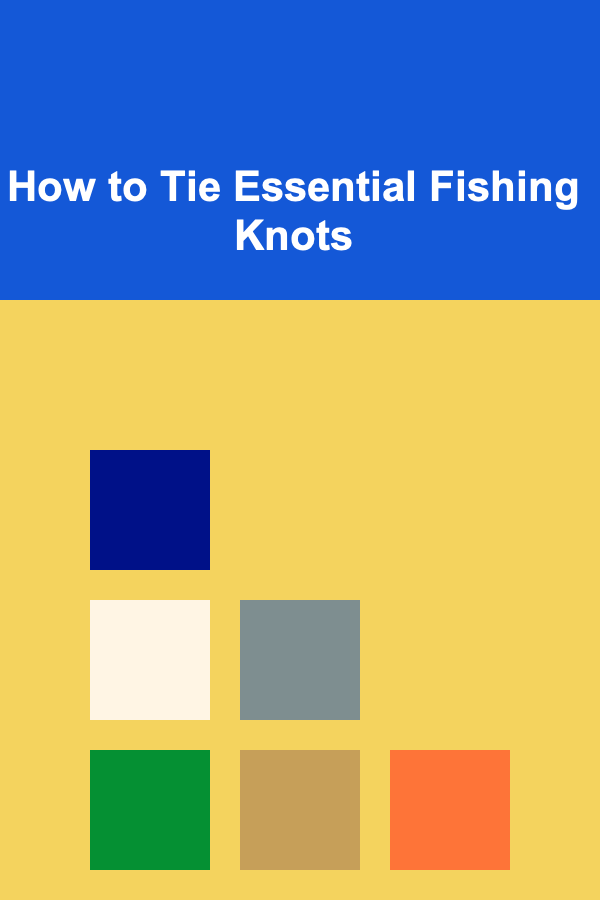
How to Tie Essential Fishing Knots
ebook include PDF & Audio bundle (Micro Guide)
$12.99$6.99
Limited Time Offer! Order within the next:

Fishing is not just about the right rod, reel, or bait; the knots you use are just as crucial to your success. A strong, reliable knot can make the difference between landing a big catch and losing it at the last second. Whether you're a seasoned angler or a beginner just starting out, mastering a few essential fishing knots is fundamental to your fishing prowess.
In this article, we will dive deep into the most commonly used fishing knots, how to tie them, when to use them, and the advantages of each. You'll learn everything you need to know to make sure your tackle holds up under pressure, ensuring you're well-equipped for your next fishing trip.
Why Fishing Knots Matter
Fishing knots are critical for ensuring that your line, hook, or lure stays securely attached while casting, reeling, and fighting fish. A poorly tied knot can slip, break, or even fail under the weight of a fish, resulting in a lost catch and wasted time. In fact, many anglers consider fishing knots just as important as the equipment they use, as a reliable knot can withstand a great deal of stress.
Different knots serve different purposes depending on the fishing situation---whether you're tying a hook, connecting different lines, or attaching a lure. Knowing the right knot for the right job can make a huge difference.
The Most Essential Fishing Knots
1. The Improved Clinch Knot
How to Tie It
The Improved Clinch Knot is one of the most widely used knots among anglers. It's simple to tie and works well for attaching hooks, lures, or swivels to fishing lines.
Steps:
- Pass the end of the line through the eye of the hook or lure.
- Twist the loose end of the line around the standing line 5-7 times.
- Pass the tag end back through the small loop formed next to the eye.
- Pass the tag end through the large loop that was created by the twists.
- Moisten the knot, then pull the tag end to tighten the knot securely.
Why Use It
The Improved Clinch Knot is highly reliable for most fishing scenarios and works well with monofilament, fluorocarbon, or braided lines. It is a quick knot to tie and offers excellent strength for holding hooks and lures in place.
2. The Palomar Knot
How to Tie It
The Palomar Knot is another incredibly strong knot, often praised for its simplicity and reliability. It's particularly effective when tying hooks, swivels, and lures to braided line or heavier lines.
Steps:
- Double about 6 inches of line and pass it through the eye of the hook.
- Tie an overhand knot with the doubled line, but don't pull it tight.
- Pass the loop over the hook or lure.
- Tighten the knot by pulling the standing line and the tag end simultaneously.
Why Use It
The Palomar Knot is extremely strong and works best with braided line, although it's also effective with monofilament lines. Its simplicity makes it easy for anglers of all skill levels to tie quickly, even in challenging conditions.
3. The Loop Knot
How to Tie It
The Loop Knot is a versatile knot often used for attaching lures that require more movement in the water, such as spinners or spoons. It allows the lure to move freely, making it more enticing to fish.
Steps:
- Pass the tag end through the eye of the hook or lure.
- Create a loop in the tag end and hold it with your fingers.
- Wrap the tag end around the standing line 5-6 times.
- Pass the tag end back through the loop you created at the beginning.
- Moisten the knot and tighten by pulling on both the standing line and the tag end.
Why Use It
The Loop Knot is excellent for lures that require freedom of movement, like topwater lures or trolling lures. It is often used for saltwater fishing, where larger fish are expected to hit the lure with more force. This knot does not constrict the lure, allowing it to move more naturally in the water.
4. The Uni Knot (or Grinner Knot)
How to Tie It
The Uni Knot is a popular and versatile knot used for tying hooks, lures, and even for joining two lines together. It's easy to tie, making it a favorite of many anglers.
Steps:
- Pass the tag end of the line through the eye of the hook.
- Form a loop by bringing the tag end back alongside the standing line.
- Wrap the tag end around the standing line 5-7 times.
- Pass the tag end through the loop and pull the knot tight.
- Trim any excess tag end and moisten the knot.
Why Use It
The Uni Knot is highly adaptable, easy to tie, and works with all types of fishing line. It's ideal for situations when you need to tie a hook or lure and is also commonly used for joining lines of different diameters. Its reliability and simplicity make it an essential knot in any angler's toolkit.
5. The Blood Knot
How to Tie It
The Blood Knot is primarily used for joining two lines together. This is particularly useful when you need to combine different diameters of line or attach a leader to your main line.
Steps:
- Align the two lines parallel to each other and overlap them by about 6-8 inches.
- Twist each line around the other 4-6 times.
- Pass each tag end through the opposite side's loops.
- Pull the lines in opposite directions to tighten the knot, then trim any excess.
Why Use It
The Blood Knot is an essential knot for joining two lines, making it useful when you need to connect a leader to your main line, or when you want to extend the length of your line. It works well with both monofilament and fluorocarbon lines, making it versatile and reliable for different fishing setups.
6. The Surgeon's Knot
How to Tie It
The Surgeon's Knot is another highly effective knot used for joining two lines together. It is simpler and faster to tie than the Blood Knot, but still offers great strength and reliability.
Steps:
- Overlap the two lines you want to join by about 6 inches.
- Tie an overhand knot with both lines.
- Repeat the overhand knot with both lines.
- Moisten and pull the knot tight.
Why Use It
The Surgeon's Knot is easier and quicker to tie than the Blood Knot, making it an excellent choice when you need to quickly tie two lines together, such as when attaching a leader. It is reliable for both braided and monofilament lines and can handle varying line diameters.
Additional Tips for Knot Tying
- Moisten the Knot: Always moisten your fishing knot before tightening it. This reduces friction and helps prevent the line from burning or weakening during the knot-tying process.
- Use Proper Line Strength: Be sure that your fishing line is strong enough to handle the weight of the fish you're targeting. This is especially important when using knots like the Palomar Knot, where the line can stretch.
- Practice Makes Perfect: While fishing knots are essential, they are also a skill that improves with practice. Take time to practice tying knots in various conditions, such as in a boat or on a windy day.
- Check Your Knots Regularly: Always inspect your knots before casting or after fighting a fish. If a knot appears weak or damaged, retie it immediately.
- Use the Right Knot for the Job: While most knots are versatile, some are better suited for specific tasks. Make sure to choose the right knot depending on your fishing line, hook, and lure.
Conclusion
Mastering essential fishing knots is crucial for any angler, whether you're casting for bass in a lake or chasing big game fish offshore. Each knot serves a unique purpose, and learning when and how to use them can greatly enhance your fishing experience. From the reliability of the Improved Clinch Knot to the versatility of the Blood Knot, these fishing knots provide the foundation for successful and stress-free fishing.
By practicing these knots and understanding their applications, you'll gain more confidence on the water, increase your catch rate, and ensure your fishing gear holds up under pressure. So, take the time to learn these knots, and you'll be ready to tackle any fishing challenge that comes your way. Happy fishing!
Reading More From Our Other Websites
- [Organization Tip 101] How to Create a Fitness Area That Promotes Mindfulness
- [Toy Making Tip 101] Best Strategies for Scaling Up Small‑Batch Toy Production While Maintaining Hand‑Made Quality
- [Personal Care Tips 101] How to Choose the Best Antiperspirant for Your Busy Lifestyle
- [Hiking with Kids Tip 101] How to Choose the Perfect Kids' Hiking Boots for Every Trail
- [Home Rental Property 101] How to Plan for Seasonal Maintenance Tasks
- [Home Renovating 101] How to Choose the Right Contractor for Your Project
- [Home Staging 101] How to Highlight Your Home's Best Features During Staging
- [Home Rental Property 101] How to Evaluate Sublet Properties for a Cost-Effective Rental Solution
- [Home Cleaning 101] How to Keep Your Home Organized with Simple Cleaning Habits
- [Organization Tip 101] How to Set Up a Home Office That Inspires Creativity

How to Create a Checklist for Enhancing Your Content's Tone and Voice: An Actionable Guide
Read More
How to Plan a Kitchen Remodel for Better Functionality
Read More
How To Practice Gratitude with a Stoic Perspective
Read More
How To Prevent Heartburn Naturally
Read More
How to Choose a Reputable Renewable Energy Installer
Read More
10 Tips for a Reading Checklist Tailored to Short Stories
Read MoreOther Products

How to Create a Checklist for Enhancing Your Content's Tone and Voice: An Actionable Guide
Read More
How to Plan a Kitchen Remodel for Better Functionality
Read More
How To Practice Gratitude with a Stoic Perspective
Read More
How To Prevent Heartburn Naturally
Read More
How to Choose a Reputable Renewable Energy Installer
Read More